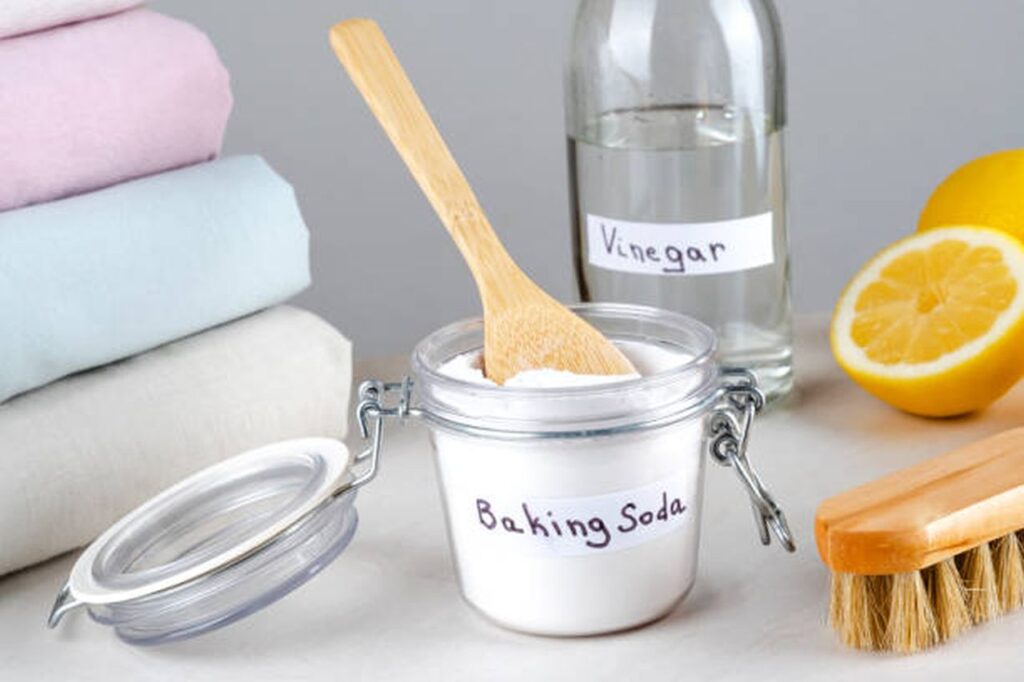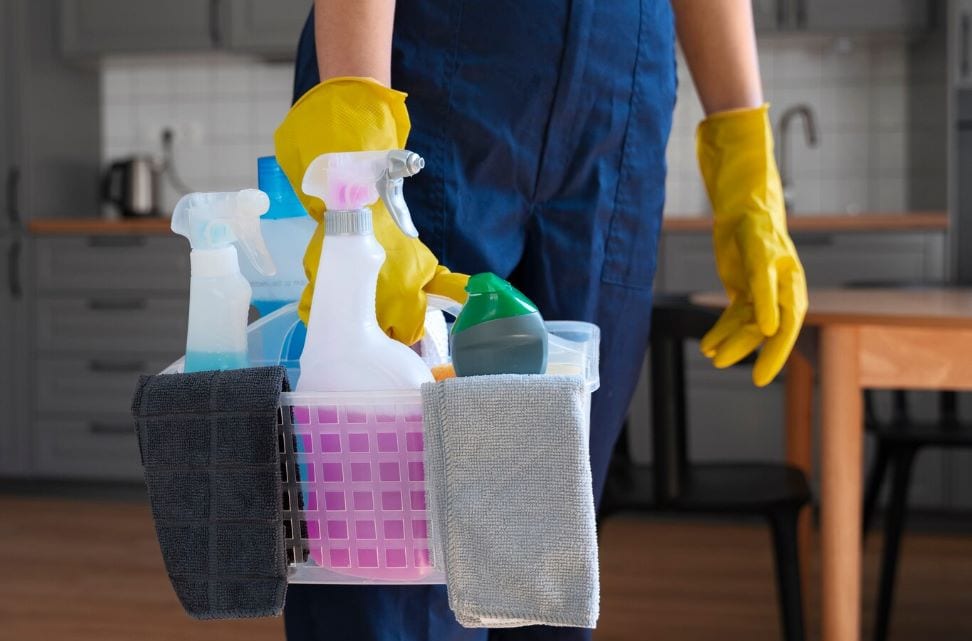Did you realise that even everyday household cleaning products might threaten your health? Cleaning chemicals is, unfortunately, a reality that many individuals must face regularly.
This is especially true of academic institutions like colleges and universities. One cannot ignore the significance of green cleaning in educational institutions. However, not everyone agrees that it's worth it. Let's examine this procedure in greater detail.
What is Green Cleaning?
Green cleaning, also known as ecological or sustainable cleaning, is an approach that uses non-hazardous materials and methods to lessen its negative effects on the environment and people's health.
Green cleaning relies on non-toxic products safe for humans and the environment, such as vinegar, baking soda, lemon juice, and essential oils. Green cleaning products are non-toxic and environmentally friendly instead of using toxic chemicals and artificial scents. By promoting the use of concentrated cleaning solutions and supporting the recycling of containers, this method also aims to reduce waste and promote sustainability.
The principles of green cleaning centre on conserving resources like water and electricity, conducting waste management and recycling in an eco-friendly manner, and using environmentally friendly cleaning products and methods. This trend is growing as people realise the benefits of reducing their carbon footprint and adopting a healthier, more sustainable lifestyle.
Why Is Green Cleaning Important?
There are several compelling arguments in favour of green cleaning, including its contribution to long-term sustainability, the protection of human health, and an improvement in quality of life.
One major benefit is that air and water pollution are greatly reduced due to the decreased use of dangerous chemicals and pollutants. Many common household cleaners contain toxic chemicals that are bad for aquatic life and soil quality in the long run.
Second, green cleaning helps keep people healthy by minimising contact with chemicals. Using conventional cleaning products often results in respiratory problems, allergies, skin irritation, and even more serious health concerns due to volatile organic compounds (VOCs) and other pollutants. Instead of synthetic chemicals, "green" cleaners stick to harmless substances found in nature.

Traditional cleaning products have a large carbon footprint due to their creation, use, and disposal. Using green cleaning products and methods, homes and businesses may lessen their environmental impact, save money on utility bills, and do their part to slow global warming.
Sustainable green cleaning practices, such as reusing containers and encouraging proper waste disposal, align with national campaigns to reduce plastic waste and encourage a circular economy.
Green cleaning is crucial to using safer, more environmentally friendly alternatives to conventional cleaning products and practices because it aligns with sustainability principles, prioritises human well-being, and helps alleviate environmental harm.
How Does Green Cleaning Work?
"Green cleaning" refers to maintaining a school that is mindful of the environment by emphasising non-hazardous materials and procedures. This approach to cleaning schools involves several concepts and practises meant to lessen the toll cleaning procedures take on students' health and the environment.
The core of eco-friendly cleaning is reusing or recycling cleaning supplies rather than buying new ones. Ingredients, including baking soda, vinegar, lemon juice, aromatic oils, and plant-based surfactants, are frequently used in such preparations.
As opposed to their conventional counterparts, green cleaning products do not include any toxic chemicals or synthetic perfumes linked to respiratory problems, skin irritations, or other health problems.
Natural Cleaning Agents
Green cleaning emphasises the utilisation of natural ingredients for cleaning. For instance, baking soda is a versatile cleaner that can scrub surfaces, neutralise odours, and act as a gentle abrasive. Vinegar is effective in removing stains and eliminating bacteria. Lemon juice, owing to its acidic properties, can dissolve mineral deposits and stains. Essential oils not only add a pleasant aroma but also possess antimicrobial properties.
Non-Toxic Cleaning Solutions
Toxic chemicals, often present in conventional cleaning agents, can harm the health of students, faculty, and staff. Green cleaning focuses on using non-toxic solutions, ensuring a safe and healthy environment. Students and staff are not exposed to harmful fumes or residues that can cause allergies, respiratory issues, or other health problems.
Environmentally Friendly Practices
Green cleaning practices extend beyond the choice of cleaning products. They encompass sustainable and environmentally conscious actions, such as reducing waste through proper dispensing systems, recycling containers, and reusing or refilling cleaning product bottles. Additionally, schools may opt for energy-efficient cleaning equipment to minimise their carbon footprint.
Waste Reduction and Recycling
Implementing waste reduction and recycling programs within school cleaning operations is crucial for sustainable practices. Using concentrated cleaning solutions helps minimise packaging waste. Recycling paper towels and refillable dispensers for cleaning agents contributes to waste reduction efforts.
Energy and Water Efficiency
Green cleaning involves utilising energy-efficient appliances and adopting water-saving practices. This includes using equipment that requires less water or opting for cold water cleaning methods to reduce energy consumption.
Proper Disposal and Recycling of Containers
Encouraging responsible disposal and recycling of cleaning product containers is an integral part of green cleaning. Providing designated bins for recycling and educating students and staff on proper disposal methods helps achieve a more sustainable approach.

Training and Education
Proper training and education are fundamental in implementing green cleaning practices effectively. Schools conduct training programs to educate custodial staff on the proper use of green cleaning products and the importance of eco-friendly cleaning procedures.
Schools positively impact the health and sustainability of their surrounding communities when they adopt green cleaning practices. In addition, it teaches students to be conscientious of their impact on the planet and encourages them to adopt sustainable practices in their daily lives, not only at school.
How Do I Choose a Green Cleaning Service?
When looking for a cleaning service, it's important to find one that uses safe methods for workers and the environment. When looking for a green cleaning service, it's important to make sure they take into account your specific environmental and health concerns.
- Certifications and Credentials: Look for certifications and accreditations from recognised organisations in the sustainability and cleaning industry. Certifications like Green Seal, EPA Safer Choice, or certifications from local environmental agencies indicate a commitment to specific environmental and health standards.
- Use of Environmentally Friendly Products: Ensure the company utilises cleaning products that are eco-friendly, biodegradable, and free from harmful chemicals. Green cleaning products should have a minimal impact on the environment and human health while effectively cleaning and disinfecting.
- Transparency in Ingredients: A reputable green cleaning company will provide transparency regarding the ingredients in their cleaning products. They should readily disclose a complete list of ingredients and any potential health or environmental risks.
- Efficient Cleaning Processes: Evaluate the company's cleaning processes to ensure they prioritise efficiency and waste reduction. Effective waste management, optimised resource usage, and energy-efficient cleaning practices are indicators of an environmentally conscious approach.
- Waste Reduction and Recycling Initiatives: Inquire about the company's waste reduction strategies and recycling initiatives. Green cleaning companies should have proper waste management protocols, including recycling programs for bottles, containers, and other materials.
- Proper Training and Education: Ensure that the cleaning company provides adequate training to their staff on green cleaning practices. The cleaning team should understand the significance of eco-friendly cleaning methods and how to use environmentally friendly products effectively.
- Health and Safety Measures: Verify that the green cleaning company prioritises the health and safety of both their employees and the occupants of the spaces they clean. They should adhere to safety protocols, including proper ventilation, and ensure the cleaning products are not harmful to human health.
- Customised Cleaning Plans: Look for a company that tailors their cleaning plans to meet your facility's specific needs and preferences. A personalised approach demonstrates a commitment to providing effective cleaning solutions while considering the unique aspects of your environment.
- Track Record and Reviews: Research the company's reputation through reviews, testimonials, or case studies. A proven track record of successful green cleaning projects and satisfied clients indicates their competence and reliability.
- Cost-Effectiveness and Value: While green cleaning may have slightly higher initial costs due to eco-friendly products, evaluate the cost-effectiveness and value. Consider the long-term benefits, such as potential cost savings, improved indoor air quality, and a healthier environment.
- Sustainability Practices Beyond Cleaning: Evaluate if the company implements sustainability practices in other aspects of their business, such as energy-efficient transportation, reducing plastic waste, or supporting community sustainability initiatives.
When looking for a green cleaning service, it is important to evaluate their policies and procedures regarding environmental friendliness, worker health and safety, openness, and compatibility with your sustainability objectives.
If you do your homework throughout the selection process, you might find a business that has the same values as you and helps to create a better place to live or work.
Conclusion
Green cleaning is a way of sustainable cleaning that avoids using toxic chemicals and other potentially harmful products. Vinegar, baking soda, lemon juice, and essential oils are some non-toxic materials it uses. Green cleaning advocates for recycling, waste reduction, and sustainability by using concentrated cleaning solutions.
Sustainable cleaning practices that are also kind to human health and well-being are crucial for the future of our planet. As a result, less toxic chemicals and other pollutants are released into the air and water. Cleaning with green products reduces exposure to harmful chemicals, protecting one from asthma attacks, allergies, and skin irritation.
Green cleaning is effective because it reduces waste by reusing or recycling cleaning materials and relies on non-toxic cleaning chemicals such as baking soda, vinegar, lemon juice, fragrant oils, and plant-based surfactants. These measures can reduce the likelihood that our kids, educators, and staff will have health conditions like asthma and allergies.
Green cleaning entails eco-friendly practices including recycling, reusing materials, and waste minimisation. By implementing these measures, schools can reduce their environmental effect and benefit the communities in which they are located. Green cleaning solutions and environmentally friendly cleaning practices are becoming increasingly popular, and schools should give sufficient training and information on their use.
Frequently Asked Questions About Cleaning Services
What is Green Cleaning, and How Does it Differ from Traditional Cleaning in Educational Settings?
Green cleaning involves using methods and products with environmentally friendly ingredients and procedures designed to preserve human health and environmental quality. Unlike traditional cleaning, which often uses chemicals that can harm the environment and human health, green cleaning products are safer and more sustainable, reducing exposure to potentially toxic chemicals.
Why is Green Cleaning Particularly Important in Schools and Universities?
Schools and universities are places where young people spend significant time. Green cleaning is crucial in these settings because children and young adults are more susceptible to the harmful effects of toxic chemicals found in conventional cleaning products. Green cleaning ensures a safer, healthier learning environment, reducing the risk of illnesses and allergies.
How Does Green Cleaning Contribute to a Healthier Learning Environment?
Green cleaning reduces harsh chemicals, which can contribute to respiratory problems, skin irritations, and other health issues. This is especially important in educational settings where students and staff are in close quarters. A healthier environment is conducive to better learning and reduces illness-related absenteeism.
Can Green Cleaning Practices in Schools and Universities Help in Reducing Environmental Impact?
Absolutely. Green cleaning practices reduce the release of harmful chemicals into the environment. This means less air and water pollution and a smaller ecological footprint for the educational institution. It also sets a positive example for students about the importance of environmental stewardship.
Are Green Cleaning Products and Practices Cost-Effective for Educational Institutions?
Initially, the switch to green cleaning products might seem more expensive. However, in the long run, it is cost-effective. Green cleaning products are often highly concentrated and offer more uses per container. Reducing health-related issues can also lead to lower healthcare and absenteeism costs, making it a financially viable option for schools and universities.
